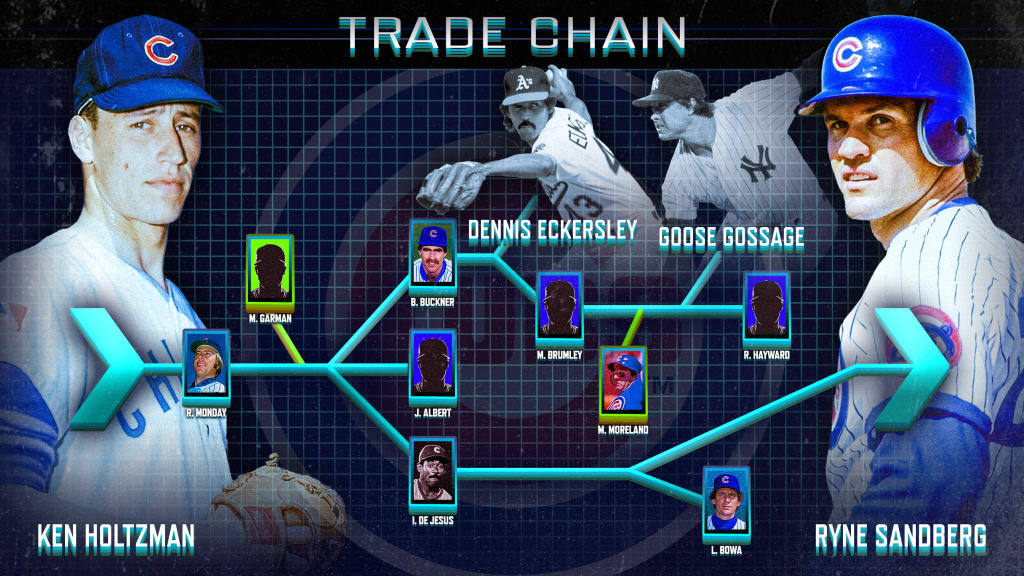
CHICAGO -- There were jokes about the Cubs becoming the Phillies West after Dallas Green left Philadelphia to become Chicago's general manager. Given the number of trades between the teams, plus the coaches and staff who changed clubs, the quips had some merit.
But Green was brought on board to begin "Building a New Tradition," as the saying went in the early 1980s, and he firmly believed he knew who to target from his former organization to help. That included zeroing in on a raw Minor League player who had a handful of players blocking a direct path to the big leagues with the Phillies.
"Ryne Sandberg, I knew from the Minor Leagues," the late Green told Carrie Muskat in her book, "Banks to Sandberg to Grace: Five Decades of Love and Frustration with the Chicago Cubs." "I knew he had the heart, and pride, and gamesmanship to make himself a player and be a good player."
When the Cubs swung a trade with the Phillies on Jan. 27, 1982, here is how the Chicago Tribune opened its news story:
The Cubs continued to retool Wednesday for what is expected to be a long climb upward by making their biggest offseason deal, acquiring Larry Bowa, an aging but feisty veteran, and an untested Minor Leaguer from the Philadelphia Phillies in exchange for Iv¨˘n de Jesus.
The author was baseball-writing legend Jerome Holtzman. That "untested Minor Leaguer" was, of course, Sandberg. The acquisition of the Hall of Fame second baseman began with another Holtzman, however. The selection of left-hander Ken Holtzman in the 1965 MLB Draft initiated a trade tree with branches to three Hall of Famers and other notable names.
June 8, 1965: Cubs select lefty Ken Holtzman in the fourth round of the MLB Draft
The first version of baseball's annual Draft had a much different structure than fans are accustomed to today. For example, the Cubs had the sixth pick in the first three rounds, but then they had the first selection in the fourth round.
After taking right-hander Rick James (first round), catcher Ken Rudolph (second) and shortstop Greg Werdick (third), that fourth-round pick was used on Holtzman, a 19-year-old sophomore pitcher out of the University of Illinois. The lanky southpaw was given a signing bonus of $65,000 and reached the big leagues with the Cubs by Sept. 4 that fall.
"My biggest thrill in my Major League career," Holtzman told the Chicago Tribune in 2015, "was not the many World Series I was in or All-Star Games, no-hitters, etc., but the very first day I suited up and walked on that beautiful green carpet alongside [Ernie] Banks, [Ron] Santo, [Billy] Williams and other players that I had read about as a kid."
Nov. 29, 1971: Cubs trade Ken Holtzman to A's for center fielder Rick Monday
Holtzman, who was heralded as the "new Sandy Koufax" when he broke into the big leagues, developed into a rotation stalwart for the Cubs. The left-hander was a key member of the beloved 1969 team that looked destined for October before collapsing down the stretch.
Through '71, Holtzman had compiled a 74-69 record to go along with a 3.59 ERA in 191 appearances for the Cubs, who were in the thick of a long postseason drought. It was that year that Holtzman asked to be traded.
"My opinion, knowing what I did from players and other teams and organizations," Holtzman told Muskat, "was that the Cubs weren't doing things the way I felt were needed to win. ... I felt I wasn't going to win a ring, regardless of the three or four Hall of Fame players on the team, unless they changed their philosophy."
So, Chicago met Holtzman's request and dealt him to Oakland, where he won three consecutive World Series championships from 1972-74. In his time with the A's, Holtzman compiled 11.0 Wins Above Replacement (Baseball Reference). But the Cubs landed a solid player in Monday -- the No. 1 overall pick in the 1965 Draft -- who amassed 11.2 WAR from 1972-76 with the North Siders.
On April 25, 1976, Monday famously became part of a moment that was captured in one of the game's great, historic photographs. When a man and his son were about to set fire to an American flag at Dodger Stadium, Monday raced over and stopped it from happening in the nick of time.
Jan. 11, 1977: Cubs trade Monday and right-hander Mike Garman to the Dodgers for first baseman Bill Buckner, shortstop Iv¨˘n de Jesus and right-hander Jeff Albert
Ahead of the 1977 campaign, the Cubs got a little younger with a five-player swap with the Dodgers. Albert never reached the Majors with the Cubs and was out of baseball by '79, but the Cubs got a light-hitting shortstop in de Jesus (1977-81) and a sound hitter in Buckner (1977-84). Buckner won the National League batting title with Chicago in '80, made the All-Star team in '81 and hit .300 over eight seasons with the Cubs.
Jan. 27, 1982: Cubs trade de Jesus to Phillies for shortstop Larry Bowa and infielder Ryne Sandberg
There were a few factors in play that led to Sandberg winding up in a Cubs uniform.
Within the Phillies' system, prospects Julio Franco and Juan Samuel were coming soon. In the big leagues, Philadelphia had Hall of Famer Mike Schmidt entrenched at third and Manny Trillo at second. Sandberg was not viewed as a solution at shortstop, and there was a school of thought that he really would only amount to being a utility man.
Even Sandberg had that thought, saying in 2005 that, "at one point, I was just hoping to be a utility infielder."
There was also a contract dispute going on between the veteran Bowa and the Phillies, who were trying to find a new home for the shortstop. Green told the Chicago Tribune in 1982: "They had to get rid of him. He had that contract problem, and then he went out on a limb and said some testy things. I knew then he'd be gone."
Enter the Cubs, who could not have known the extent of the transactional coup they pulled off at the time. They knew they could land Bowa, and insisted on having the "untested Minor Leaguer" included in the trade.
By 1984, Sandberg was the NL MVP and the Cubs -- with Bowa at shortstop -- won the NL East (the franchise's first postseason berth since 1945). Manager Jim Frey worked with Sandberg on unlocking his power, and he went on to set the then-career MLB record for homers by a second baseman. Sandberg was a nine-time NL Gold Glove Award winner, a 10-time All-Star and an eventual Hall of Famer.
"Dallas Green brought me to Chicago and without him, who knows?" Sandberg said in his Hall of Fame induction speech. "I couldnĄŻt let him down. I owed him too much. I had too much respect for him to let him down."
Sandberg's retirement after the 1997 season officially brought an end to the Holtzman trade tree, which included a few other notable branches.
May 25, 1984: Cubs trade Buckner to Red Sox for right-hander Dennis Eckersley and infielder Mike Brumley
Buckner began the '84 campaign with the Cubs, but he was dealt to Boston for Eckersley, who was still a starter at the time, and Brumley, who gave Chicago 39 underwhelming games in '87. Eckersley was strong down the stretch for the NL East-clinching Cubs and remained with the club into the '87 campaign.
Buckner, meanwhile, told the Chicago Tribune that he welcomed the change of scenery.
"Dallas did me a favor,'' Buckner said. ''I knew I was going to be traded. I remember my wife and I talking about it and saying we'd like to go to Boston. But I didn't ask for Boston. ... Maybe it was a good thing. If I had said I wanted to go to Boston, Dallas might have sent me the other way.''
Those comments were printed on Oct. 22, 1986. Three days later, the Mets' Mookie Wilson sent a grounder through Buckner's legs to walk off the Red Sox in Game 6 of the World Series. The Mets then won it all in Game 7.
April 3, 1987: Cubs trade Eckersley and infielder Dan Rohn to A's for infielder Brian Guinn and right-handers Mark Leonette and Dave Wilder
In one of the most lopsided trades in baseball history, the Cubs shipped Eckersley to the A's for a trio of players who never saw the Majors. Under manager Tony La Russa and pitching coach Dave Duncan in Oakland, though, Eckersley helped redefine bullpen usage. Eckersley was converted into a closer and emerged as an elite stopper that helped the A's reach three World Series, including a championship in '89.
Feb. 12, 1988: Cubs trade Brumley and utility man Keith Moreland to Padres for right-hander Goose Gossage and left-hander Ray Hayward
After trading Hall of Fame closer Lee Smith to the Red Sox in December 1987, the Cubs tried to fill that hole by reeling in another Hall of Famer in Gossage.
"He can still do the job as a short man," Cubs GM Jim Frey told the Associated Press at the time.
By that time, however, Gossage's famous fastball had faded, and he managed only 13 saves with a 4.33 ERA in 46 outings. He was released the following spring. In March 1988, the Cubs flipped Hayward to the Rangers for outfielder Dave Meier and infielder Greg Tabor. Meier appeared in two games for Chicago in '88, while Tabor never reached the Majors with the Cubs.


